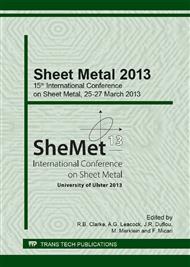p.452
p.463
p.471
p.477
p.484
p.492
p.503
p.511
p.521
On the Field Variables Influence on Bonding Phenomena during FSW Processes: Experimental and Numerical Study
Abstract:
Solid state bonding recurs in several manufacturing processes, as Friction Stir Welding (FSW), Linear Friction Welding (LFW), extrusion of hollow profiles and Accumulative Roll Bonding (ARB). The former processes are nowadays of particular industrial interest because of the specific advantages with respect to the classic welding technologies. In FSW the solid state bonding is obtained between an undeformed cold material, already placed in the advancing side of the joint, and the hot material flow incoming from the retreating side. Proper conditions of pressure, temperature, strain and strain rate are needed in order to get the final effective bonding. In the paper experimental tests on butt joints made out of AA6061-T6 aluminum alloys are used to identify the sets of process parameters resulting either in sound or poor joints. The same process conditions have been simulated used an already developed model in order to highlight the actual bonding line and the values of the main field variables determining the soundness of the joints. Finally a correlation between process parameters values, field variables values and joint effectiveness is made.
Info:
Periodical:
Pages:
484-491
Citation:
Online since:
April 2013
Authors:
Keywords:
Price:
Сopyright:
© 2013 Trans Tech Publications Ltd. All Rights Reserved
Share:
Citation:


